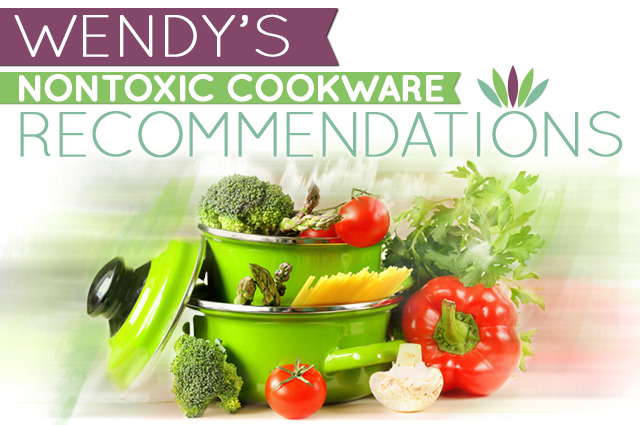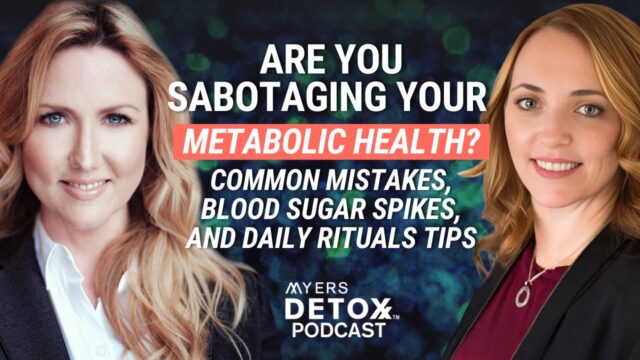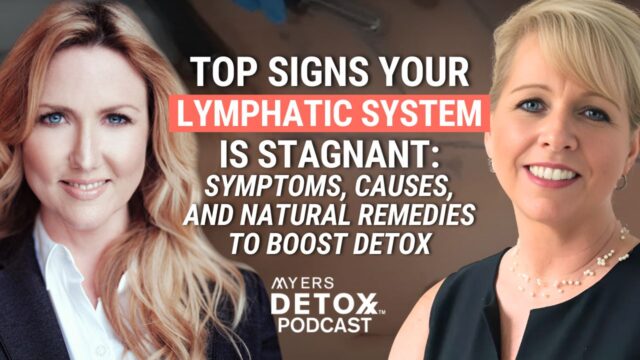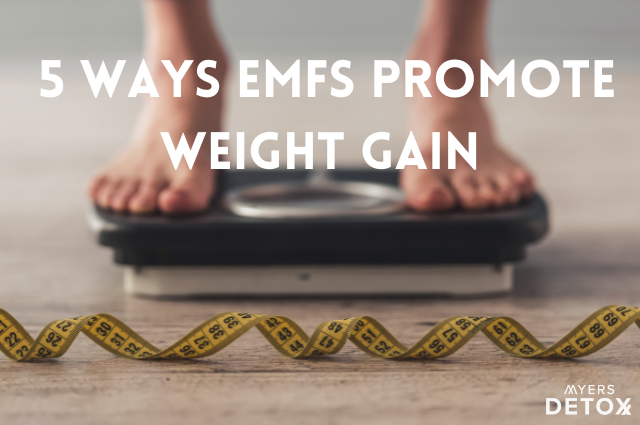We all know about the dangers of toxins in air, water, and food, but studies are now showing that our cookware could be polluting your body. Here are my recommendations for nontoxic cookware.
That means that you can carefully choose the right foods for a healthy diet but still be exposed to dangerous toxins through your kitchen equipment. The ultimate goal is optimal health and well being. Don’t let your cookware ruin your progress!
It is a long and costly process for eco-conscious consumers to switch completely from cookware coated with toxic finishes to those that are nontoxic. Do it one step at a time: take inventory of the Teflon and non-stick items in your kitchen, and replace each item with a nontoxic version throughout the year.
One of my favorite resources for nontoxic cookware and utensils is Eartheasy.com. They have a HUGE selection of ecofriendly products to create the dream ecofriendly kitchen.
Recommended Cookware
I recommend the following types of nontoxic cookware and use them in my kitchen almost daily.
Stainless Steel
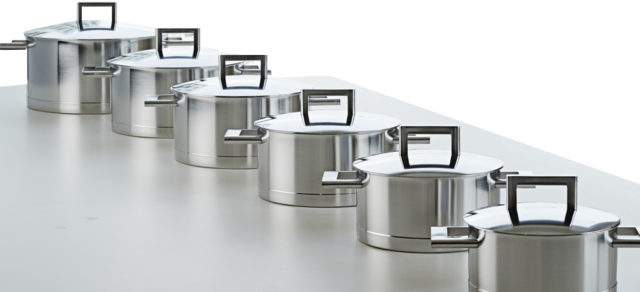 Stainless steel is a great choice for cookware. Stainless steel is an alloy of iron, nickel and chromium and sometimes other metals like molybdenum. The actual stainless steel used in stainless steel cookware is an iron-based metal alloy that must contain 11% chromium and up to seven additional metals (but never lead or aluminum). Chromium provides durability and rust resistance. Although nickel is not required, it provides rust resistance, hardness and high polishing characteristics. Nickel makes stainless steel shiny.
Stainless steel is a great choice for cookware. Stainless steel is an alloy of iron, nickel and chromium and sometimes other metals like molybdenum. The actual stainless steel used in stainless steel cookware is an iron-based metal alloy that must contain 11% chromium and up to seven additional metals (but never lead or aluminum). Chromium provides durability and rust resistance. Although nickel is not required, it provides rust resistance, hardness and high polishing characteristics. Nickel makes stainless steel shiny.
High quality options, labeled 18/10 for its alloy composition, will not react with your food, even at high temperatures. The 18/10 ratio stainless steel consists of 18% chromium and 10% nickel. If you are allergic to nickel try a stainless ratio with less nickel like 18/8 or 18/0 or avoid stainless steel.
I highly recommend All Clad or Demeyere. Both come with lifetime warranties. You want to go for quality when it comes to stainless steel. There are few regulations on stainless steel in the US and lower quality brands can contain lead. Best to go with reputable brands to be on the safe side. To select the least reactive grade of cookware, see A Buyers Guide to Stainless Steel Cookware.
When using stainless steel cookware, know that deeply scratched and pitted pans can cause metals (nickel and chromium) to migrate into food in trace amounts. To play it safe and preserve the safety of stainless steel, avoid use of abrasive cleaners and pads, including steel wool, with cleaning stainless steel cookware.
Ceramic
 Ceramic cookware is a great alternative to other toxic options on the market. With ceramic cookware, you can enjoy a versatile cooking experience that gives you healthy, tasty results and easy cleanup to boot. They are technically dishwasher, oven, microwave and stove safe and can be scrubbed with anything.
Ceramic cookware is a great alternative to other toxic options on the market. With ceramic cookware, you can enjoy a versatile cooking experience that gives you healthy, tasty results and easy cleanup to boot. They are technically dishwasher, oven, microwave and stove safe and can be scrubbed with anything.
My favorite brand is Xtrema Ceramic Cookware. Their ceramic is naturally durable and non-reactive — it won’t change the taste of dishes. This durability also means you can use Xtrema safely under high temperatures and freezing temperatures alike.
Xtrema ceramic cookware is made of 100% inorganic ceramic minerals and so is the ceramic non-scratch glaze. All ceramic glazes are made of various inorganic minerals and oxides. The oxides give the glaze its strength, color and glossiness. Xtrema ceramic cookware and its ceramic glaze contain no metals or lead and cadmium. Xtrema passes all FDA standards for lead and cadmium. Xtrema publishes test results on their web site. Here is a link to the certificate showing the exact levels of these substances in Xtrema cookware.
My favorites are the 10 inch skillet, and the 3.5 Quart Saucepan, which I use to cook soups, heat foods, and even bake in. I, however, don’t like the larger pans on stove-top because the heat does not distribute evenly on them (as they’re too big), but I do like the smaller pans for the stove-top. Another downside is that they can break and chip easily. So be careful when using these!
As a bonus for being a part of the Myers Detox, you’ll receive 5% off your entire purchase on their website! Use the code: DetoxM to redeem your savings. The offer applies to all non-sale items.
Glass
Glass is great – it is affordable, inert and nonporous. Although it can’t be used on the stovetop, it bakes food faster than metal cookware because it holds heat longer.
My favorite glass cookware should come at no surprise: Pyrex. It’s tried and true in the cookware department. Pyrex simply offers an endless variety of options for your glass chemical-free bake ware needs at an affordable price point. Corningware is great too!
Enamel
Enamel cookware encases the iron base metal with a coating of porcelain (which is powdered glass melted and baked on top of the metal). While enamel cookware is typically easy to care for, it will likely be your most expensive option.
Enamel also doesn’t have the non-stick qualities of bare iron or stainless steel cookware so it’s not very good for cooking eggs. However, enameled cookware is considered better for acidic dishes, soups, and sauces, as there are no metal surfaces to chemically react with the food. Another advantage of enamel is that it won’t hold flavors, like fish, the way that cast iron does.
Le Creuset, Le Chasseur and Staub are a little on the pricy side but they come with a lifetime warranty.
Once enamel cast iron is chipped, throw it out because it leaks toxic metals.
Titanium
Titanium is nontoxic, non-reactive and lightweight, but a poor heat conductor. Typically what is labeled titanium cookware is actually aluminum that has a fused ceramic-titanium, nonstick coating. It’s expensive, but durable and a healthful, nonreactive choice.
Bamboo
Nontoxic Bamboo steamers and paddles as well as wooden spoons, utensils, chopsticks and crockery are non-reactive and considered to have no harmful effects on food during cooking. Make sure they are organic and paint and stain free. For food preparation, bamboo cutting boards are a sustainable alternative to traditional wooden cutting boards. Bamboo is an earth-friendly, fast-growing renewable resource. It grows rapidly without chemical fertilizers, and can be harvested in just 3-5 years.
Nontoxic Food Storage
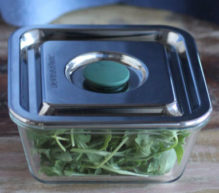 Live a life without plastic! Plastic is very toxic to your body – even BPA free. Practical, airtight and watertight, Radiant Life food storage containers are perfect for healthy food storage. They’re ideal containers for lunch on the go and can be re-heated in a toaster oven without the lid. Click here to see more choices for nontoxic storage containers
Live a life without plastic! Plastic is very toxic to your body – even BPA free. Practical, airtight and watertight, Radiant Life food storage containers are perfect for healthy food storage. They’re ideal containers for lunch on the go and can be re-heated in a toaster oven without the lid. Click here to see more choices for nontoxic storage containers
Nontoxic Cooking Utensils
We can’t forget to detox these staples in the kitchen! Avoid plastic utensils and accessories when cooking as these can melt or flake with extreme heat or wear down over time potentially causing chemicals to migrate into food. Instead choose stable materials such as wood, bamboo, silicone coated or stainless steel.
Be wary of buying pans and cookware that have plastic cookware handles. If they get too hot, they may emit toxic fumes. Choose cookware with handles that stay cool on the stovetop for a reasonable amount of time but are oven-safe.
Avoid these types of Cookware
The following cookware I recommend avoiding at all costs. Some are typically thought of as healthy cookware, while others will definitely contribute to toxicity in your life.
Avoid most Nonstick cookware
Teflon, Excaliber and Silverstone, are the usual names nonstick cookware is marketed under. Nonstick cookware made from DuPont’s trademark Teflon product is the most popular type of cookware sold. Throw out all Teflon coated nonstick cookware in your cupboards, especially those that are old, scratched and chipped! They have no place in a healthy kitchen. I give my recommendations for nontoxic nonstick cookware below.
Stay away from cookware that are sold under names Fluron, Supra, Greblon, Duracote, Rsistal, Autograph, Unison, Swiss Diamond and T-Fal as these also contain toxic nonstick PFOE coatings.
Teflon is made from the chemical PFOA, which can leach into the food when cooking. According to the Environmental Working Group, nonstick coatings can “reach 700 degrees Fahrenheit in as little as 3-5 minutes, releasing 15 toxic gases and chemicals, including two carcinogens.” At high heat the fluoropolymers used in nonstick finishes release various toxic substances, and at least one greenhouse gas.
The greatest concerns surround perfluorooctanic acid (PFOA), a substance that persists in the environment and widespread use of which has made it detectable in the blood of almost all Americans, adults and newborns alike. PFOA is considered a likely carcinogen and is associated with changes in thyroid hormone levels (1), raised levels of cholesterol and birth defects. It is known to cause testicular, pancreatic, mammary and liver tumors in rats, and workers exposed to PFOA have increased risk for cancers of the pancreas and the male reproductive tract.
Additionally, overheated chemical nonstick finishes release fumes that cause an illness in humans known as polymer fume fever. These fumes lead to flu-like symptoms such as chills, fever, body aches, nausea and occasional vomiting.
My first choice for nonstick cookware is a product called ScanPan. It is a very high quality nonstick pan that I absolutely could not live without. Scanpan nonstick technology relies upon their own research and development team to develop safe nontoxic coatings. Scanpan’s patented titanium nonstick surface is so durable that it has a lifetime guarantee. But what’s particularly important is that it does NOT outgas any toxic fumes even when overheated which is usually characteristic of nonstick surfaces.
Zwilling JA Henckels Spirit Cookware has amazing user reviews for nontoxic cookware and is very safe. This has a stainless steel exterior and a lifetime warranty.
One company, Green Pan, uses a patented technology called Thermolon to make their pans non-stick and heat resistant up to high temperatures.
Avoid Cast Iron
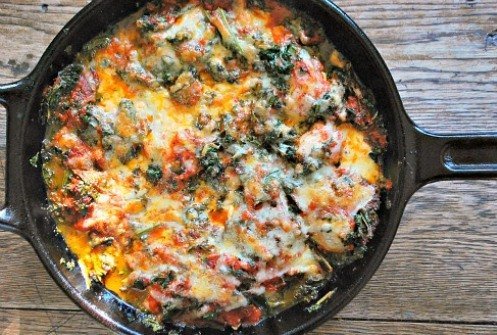 Cast iron cookware is a staple in many kitchens. However, when cast iron is raw and uncoated, this cookware leaches toxic iron into food making its use harmful. This is a form of iron completely different than the kind found in foods like red meat and vegetables, which our bodies need.
Cast iron cookware is a staple in many kitchens. However, when cast iron is raw and uncoated, this cookware leaches toxic iron into food making its use harmful. This is a form of iron completely different than the kind found in foods like red meat and vegetables, which our bodies need.
Some people believe that they can get iron from a cast iron pot. The reality is that iron comes in a ferrous and a ferric form. Ferrous iron is what makes our blood red and comes from our foods. Our body cannot properly assimilate or utilize the iron (ferric) from a cast iron pan. Ferric iron in its raw iron form when ingested gets treated by the body as a heavy metal and ends up getting stuck in the liver and kidneys. This iron accumulates over time, contributing to joint pain/arthritis, diabetes, anger, heart disease, digestive issues, depression, 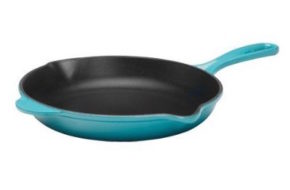 impotence, early menopause, and other issues have been attributed to iron toxicity. Listen to this podcast about iron toxicity.
impotence, early menopause, and other issues have been attributed to iron toxicity. Listen to this podcast about iron toxicity.
My suggestion? Invest in a coated cast iron skillet! Le Creuset and Staub have enamel-coated cast iron skillets that prevents iron leaching and keeps metal from reacting with your food. The enamel is essentially iron with a glass coating over it.
Avoid Aluminum
Aluminum cookware is appealing because of its low price. Aluminum is highly toxic and it is absorbed into any food it is used to prepare.
Aluminum, Anodized Aluminum, and Cast Aluminum is to your central nervous system as cigarette smoke is to your lungs. Scientists have proven aluminum damages brain tissue and can lead to degenerative disease by producing oxidative stress. The sale of aluminum cookware is prohibited in Germany, France, Belgium, Great Britain, Switzerland, Hungary and Brazil for a reason.
Hard-anodized aluminum is not safe either. It will still leach aluminum into your food. The electrochemical anodizing process “locks in” the aluminum, but anondization can break down over time.
I always know when I have a client that is using aluminum cookware because they have extremely high aluminum on their hair mineral analysis or other metals tests. Aluminum toxicity has been linked to Alzheimer’s disease, impaired visual motor coordination and estrogen-related cancers. This type of cookware and aluminum utensils is a definite no-go.
If you use aluminum baking sheets for cooking, remember to line them with parchment paper coated with silicone, not paraffin wax. That way you don’t get the aluminum in your food!
Avoid Ceramic Coated
To make the so-called ceramic coatings, a chemically based polymer is melded onto an anodized metal surface. As these synthetic, plastic-like coatings are softer than metal, you can imagine what will happen. With normal use the polymer degrades. The life expectancy of a nonstick ceramic-coated pot or knife is about one year. It easily chips, wears thin, or scratches exposing an underlying reactive metal that contaminates food with toxic metals like lead and cadmium and/or enamel fragments. And the coating itself may contain toxic metals like arsenic. Do NOT use ceramic-coated cookware.
Avoid Copper Cookware
Copper is a reactive metal and will leach into food. The FDA has cautioned about the use of copper utensils and pans. Unlined copper cookware can leach into foods when cooking, so many countries and states have restricted the sale of these products.
Since copper is superbly heat conductive, many brands are what are called ‘Clad’, meaning they use copper inside the cookware wrapped by other safe alloys (mostly stainless steel) for better performance. These are perfectly safe as long as the copper is not on the cooking surface.
Avoid Silicone
Silicone is a synthetic rubber which contains bonded silicon (a natural element which is very abundant in sand and rock) and oxygen. Cookware made from food grade silicone has become popular in recent years because it is colorful, nonstick, stain-resistant, hard-wearing, cools quickly, and tolerates extremes of temperature. There are no known health hazards associated with use of silicone cookware.
But some consumers report that silicone does offgas, and raise concerns that additives may include petroleum or other harmful ingredients. While silicone cookware may be funky and fun, there is not a lot of evidence yet about safety or harm. In the past, the health hazards of some new products, like Teflon, were not revealed for several decades. In the case of silicone, it might be more sensible to be cautious.
A 2005 British study determined low overall chemical migration from silicon into foodstuffs, so it does occur. Do not use silicone cookware at temperatures above 220°C (428°F) as it will melt if exposed to high temperatures . You should also be careful when removing hot foods from flexible silicone cookware, as the food may slide out very quickly. If you use silicone cookware, purchase only 100% silicone that is FDA approved and safe up to 428 degrees Fahrenheit). This is critical as there are countless silicone formulas and some products, such as the popular bake sheets, are only silicone coated.
I hope this article brought some clarity to choices you should be making when it comes to cookware. I found that a lot of clients that I work with think they are cooking in nontoxic cookware, when in fact they are not. There’s no point in cooking healthy meals at home if you’re introducing toxins and chemicals back into your food!


